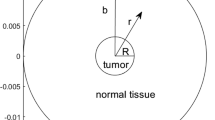Abstract
A distributed optimal control problem for a system described by a bio-heat equation for a homogeneous plane slab of tissue is analytically investigated. The required tissue temperature at a particular location of the tumour in hyperthermia can be attained within the total operation time of the process due to induced microwave radiation which is taken as control. The tissue temperature against the tissue length at different operation time of the process is considered to attain the desired temperature of the tumor.
Similar content being viewed by others
Abbreviations
- c :
-
specific heat of tissue, J/(kg·°C)
- h :
-
heat transfer coefficient between skin and ambient air, W/(m2·°C)
- k :
-
thermal conductivity of tissue, W/(m·°C)
- L :
-
lengthofplate, m
- x 1 :
-
desired position of heating (center of tumor), m
- χ :
-
temperature, °C
- χ a :
-
arterial temperature, °C
- χ 0 :
-
initial temperature, °C
- u(t):
-
temperature of surrounding medium, °C
- χ*:
-
desired temperature to be attained, °C
- T :
-
total time of process, s
- t 1 :
-
switching time, s
- Q(t):
-
heat generation rate due to volumetric heating, W/m3
- ρ :
-
density of tissue, kg/m3
- δ :
-
dirac-delta function
- ω :
-
product of flow and heat capacity of blood, W/(m3·°C)
- Q m :
-
rate of metabolic heat generation, W/m3
References
Deng, Z. S. and Liu, J. Analytical study on bioheat transfer problems with spatial or transient heating on skin surface or inside biological bodies. Journal of Biomechanical Engineering 124(6), 638–649 (2002)
Dhar, P. K. and Sinha, D. K. Optimal temperature control in hyperthermia by artificial surface cooling. International Journal of Systems Science 20(11), 2275–2282 (1989)
de Wagter, C. Optimization of simulated two-dimensional temperature distributions induced by multiple electromagnetic applicators. IEEE Transactions on Microwave Theory and Techniques 34(5), 589–596 (1986)
Butkovasky, A. G. Distributed Control System, American Elsevier Publishing Company, New York, 334–335 (1969)
Dhar, P. K. and Sinha, D. K. Temperature control of tissue by transient-induced microwave. International Journal of Systems Science 19(10), 2051–2055 (1988)
Das, S. K., Clegg, T. S., and Samulski, T. V. Computational techniques for fast hyperthermia temperature optimization. Medical Physics 26(2), 319–328 (1999)
Kowalski, M. E., Behnia, B., Webh, A. G., and Jin, J. M. Optimization of electro-magnetic phased arrays for hyperthermia via magnetic resonance temperature estimation. IEEE Transactions on Biomedical Engineering 49(11), 1229–1241 (2002)
Loulou, T. and Scott, E. P. Thermal dose optimization in hyperthermia treatments by using the conjugate gradient method. Numerical Heat Transfer, Part A: Application 42, 661–683 (2002)
Kowalski, M. E. and Jin, J. M. A temperature-based feedback control system for electro-magnetic phased arrays hyperthermia: theory and simulation. Physics in Medicine and Biology 48, 633–651 (2003)
Bagaria, H. G. and Johnson, D. T. Transient solution to the bio-heat equation and optimization for magnetic fluid hyperthermia treatment. International Journal of Hyperthermia 21(1), 57–75 (2005)
Cheng, K. S., Stakhursky, V., Craciunescu, O. I., Stauffer, P., Dewhirst, M., and Das, S. K. Fast temperature optimization of multi-source hyperthermia applicators with reduced-order modelling of ‘virtual sources’. Physics in Medicine and Biology 53(6), 1619–1635 (2008)
Kuznetsov, A. V. Optimization problems for bio-heat equation. International Communications in Heat and Mass Transfer 33, 537–543 (2006)
Lee, E. B. and Markus, L. Foundations of optimal control theory. The SIAM Series in Applied Mathematics, John Wiley and Sons, New York, 20 (1967)
Arora, D., Minor, M. A., Mikhail, S., and Roemer, R. B. Control of thermal therapies with moving power deposition field. Physics in Medicine and Biology 51, 1201–1219 (2006)
Author information
Authors and Affiliations
Corresponding author
Additional information
Communicated by Zhe-wei ZHOU
Rights and permissions
About this article
Cite this article
Dhar, P., Dhar, R. Optimal control for bio-heat equation due to induced microwave. Appl. Math. Mech.-Engl. Ed. 31, 529–534 (2010). https://doi.org/10.1007/s10483-010-0413-x
Received:
Revised:
Published:
Issue Date:
DOI: https://doi.org/10.1007/s10483-010-0413-x




